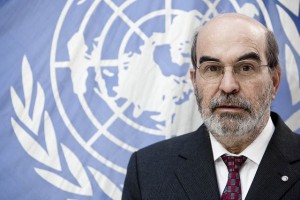Wednesday, April 24, 2024
News and Views from the Global South
Food and Agriculture
Feeding a Warmer, Riskier World
José Graziano da Silva is Director-General of the Food and Agriculture Organization of the United Nations (FAO).
- Artificial meat. Indoor aquaculture. Vertical farms. Irrigation drones. Once the realm of science fiction, these things are now fact. Food production is going high tech – at least, in some places.
But the vast majority of the world’s farmers still face that old and fundamental fact: their crops, their very livelihoods, depend on how Mother Nature treats them. Over 80 percent of world agriculture today remains dependent on the rains, just as it did 10,000 years ago.
At the Second International Conference on Nutrition held in Rome last November, Pope Francis said: “God forgives always; men, sometimes; the Earth, never. Mother Nature can be rough – and she’s getting rougher as our planet’s climate changes.”
When drought, floods, tsunamis or severe weather hit, the consequences for people’s food security and economic well-being can be profound. Beyond the disaster-provoked hunger crises that make newspapers headlines, the development trajectories of entire nations and regions can be seriously altered by extreme events.
Remember: In many developing countries farming remains a critical economic activity. The livelihoods of 2.5 billion family farmers depend on agriculture, and the sector accounts for as much 30 percent of national GDP in countries like Burkina Faso, Burundi, Central African Republic, Chad, Ethiopia, Kenya, Mali, Niger and Mozambique, among others.
It is not only drought, floods, and storms the pose a threat to agriculture, by the way. Diseases and pests like Small Ruminants Plague (PPR), or desert locusts or wheat rusts do as well. Nor is harsh weather the only threat: wars, economic crises – the work of humans – frequently wreak havoc on agricultural communities and infrastructure.
Conflicts, natural hazards have always threatened food security. However today we are witnessing their aggravation. Economic losses due to natural disasters have tripled over the last decade – and continue to rise.
Initial results from a new FAO study show that losses and damages to crops and livestock, fisheries and forestry due to natural hazards accounted for at least 22 percent of the total bill between 2003 and 2013.
Small scale farmers, herders, fishers and forest-dependent communities, who generate more than half of global agricultural production, are particularly at risk. (By the way, these very same people make up 75 percent of the world’s poor, hungry and food insecure population.)
So how can we ensure food security in a world with ever more people, exposed to ever more intense and frequent hazards?
Agriculture itself can provide solutions. It is a main driver for land use changes and can therefore be instrumental in increasing vulnerabilities to natural hazards. At the same time, a more sustainable approach to food production would help us protect the environment and build the resilience of our communities in the face of disasters.
Over the past decade, good progress has been made in fleshing out the concept of disaster risk reduction and its vital contribution to inclusive and sustainable development. Yet more must be done to harness the potential of agriculture in reducing disaster-related risks and to factor agriculture, food security and nutrition into strategies for bolstering up the resilience of societies.
Next week, world leaders and the international development community will gather in Sendai, Japan, to chart a pathway for a broad-reaching and holistic global approach to disaster risk reduction.
The Food and Agriculture Organization (FAO) of the United Nations will be taking the message to the World Conference on Disaster Risk Reduction (Mar. 14-18) that risk-sensitive development in the agriculture-food-nutrition sector is an essential building block for enhancing overall global resilience to disasters.
Our vision for ensuring that agriculture both benefits from and contributes to disaster risk reduction rests on four mutually reinforcing pillars that are applicable at the local, national, regional and global levels.
First, we must manage risk. This includes developing legal and regulatory frameworks for risk reduction and crisis management and building capacities at all levels to implement them. Risk factors need to be systematically factored into agriculture, fisheries and forestry planning, from step one.
Second, we have to watch to safeguard, establishing better information-gathering and early warning systems to identify threats. Then we must be proactive and act before disaster hits. In the past, the global community received early warning of impeding crisis, but did not react. The 2011 famine in Somalia is a recent and sobering example.
Third, we need to reduce the underlying risk factors that make farmers, pastoralists, fishers and foresters vulnerable. This can be achieved by focusing on – and investing in – more sustainable models of food production and the use of improved agricultural technologies and practices which raise yields and boost resilience against shocks while protecting the natural resource base.
There is a rich tool kit of options already available, such as conservation agriculture and agroforestry, strengthening producer organisations, or establishing field schools to disseminate best practices, to name just a few.
Finally, maintaining a state of readiness to allow for rapid responses to the needs of the food production sector if disaster does hit is also key. Despite massive damage, agricultural livelihoods in the Philippines were rapidly restored after 2013’s Typhoon Haiyan thanks to appropriate national-level preparedness and timely international community support.
Sendai – and July’s development financing conference in Addis Ababa and the Paris 2014 climate summit – give us a chance to hard-wire resilience into the post-2015 development agenda. Agriculture – and the many, diverse communities that make it up – can and should be the bedrock on which increased resilience for millions of people is built.
Edited by Kitty Stapp
-
lily hidalgo
-
OdinsAcolyte

 Print
Print




